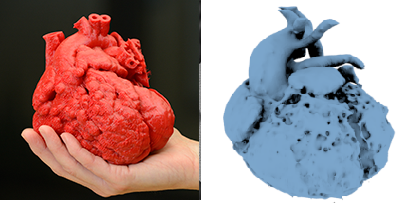
Now, eight years after he first discovered 3D printing, Dr. Bramlet and several other experts have published an article on the impact of 3D printing on the treatment of congenital heart disease, appropriately titled “The Impact of Three-Dimensional Printing on the Study and Treatment of Congenital Heart Disease.” You can read the full article in Circulation Research here.
We cover a lot of stories about 3D printed medical models, but you may have noticed that a disproportionate number of those stories have to do with heart conditions. That’s not a coincidence; as the researchers explain, the heart is especially well-suited to being 3D printed.
“Although there are 3D printing case reports in almost every subspecialty of medicine to date, the rate of adoption in the field of congenital heart disease (CHD) is particularly advanced,” the article states. “This is due, in no small part, to the fact that the heart is a hollow organ, which makes it a perfect substrate for 3D printing. More importantly, medical decision-making in CHD is informed by assessment of the anatomic morphology of the heart because cardiac pathology is a direct manifestation of the underlying 3D structure.”
The researchers present two cases in which a 3D printed heart model was integral in the success of a cardiac surgery, one involving a four-year-old girl and one involving a 31-year-old adult. Despite the encouraging case studies, however, the use of 3D printed cardiac models isn’t yet a mainstream practice, likely due to the following reasons:
- Startup costs. The researchers cite the high costs of 3D printers, materials and, perhaps most of all, licenses for 3D segmentation software. While there are open-source software options, they have a “steep learning curve,” according to the article.
- Lack of expertise. Speaking of learning curves, there are still plenty of medical professionals who aren’t yet well-versed in 3D technology, and, as the researchers point out, translating medical data into 3D models is a complex, multifaceted process that typically requires a team approach, with experts in imaging and anatomic pathology working together with experts in CAD files and 3D printing.
“As with any handoff in medicine, there needs to be extreme care taken that essential information is not lost at some point in the process,” the researchers point out. “Additionally, we cannot ignore the critical need to ensure the accuracy and quality of 3D models, both digital and physical, when used in the healthcare setting. For this reason, high-level expertise and training will be essential, along with standards and metrics against which 3D models should be measured.”
- Lack of incentive. This is surprising, considering the case studies that have shown the lifesaving potential of 3D medical modeling, but hospital administrators are dependent on insurance companies to reimburse them for the cost of introducing advanced 3D printing capabilities into their facilities, and at this point, insurance companies are still hesitant to support the technology without further quantitative proof of improved patient outcomes and financial savings. The researchers suggest that pilot studies, funded by the research community, are needed to generate this quantitative proof.
We recently had some good news on that front, as Stratasys has launched a clinical study of the outcomes of pediatric heart surgeries in which 3D printed heart models were used vs. surgeries in which they weren’t used. The article goes on to explain the process of turning a patient scan into a 3D printed model, and further details the mission of the 3D Heart Library as a subset of the National Institutes of Health 3D Print Exchange.
“The value 3D anatomic models play in the improved understanding of congenital heart lesions is being increasingly recognized,” the researchers conclude. “We think that the congenital heart community should look to a future where 3D printing will be incorporated in the medical decision-making process as a standard practice of care. To that aim, we are advocating for standards and recognition of scholarly contribution to build a database of 3D heart models complete with quality metrics for inclusion, a transparent process for validation of a model, and academic credit for contributions to the 3D Heart Library, which meet these standards.”
Additional authors include Laura Olivieri, Kanwal Farooqi, Beth Ripley and Meghan Coakley. Discuss in the 3D Heart Library forum at 3DPB.com.
